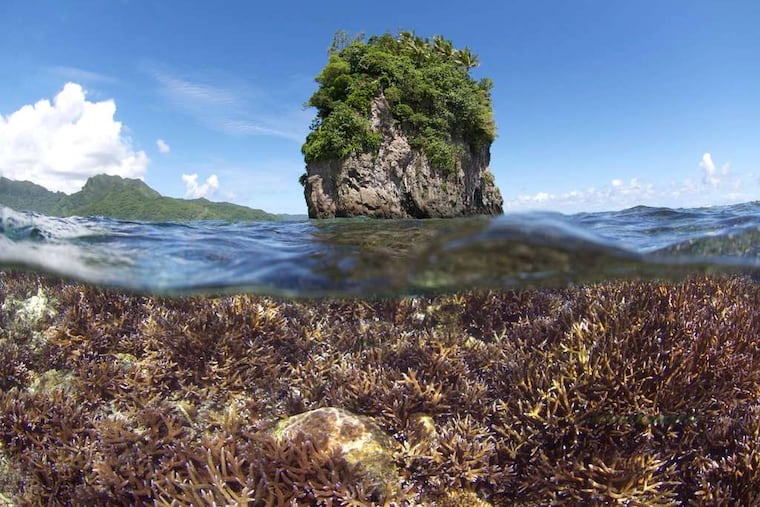Pacific Islanders are too often excluded from Asian American and Pacific Islander Heritage Month
Jeannie Mai Jenkins’ exclusion of Pacific Islanders is nothing new — in fact, it’s built into our systems.

“Just do the Asian in #AsianHeritageMonth.”
These were the words of TV personality Jeannie Mai Jenkins last month when she cohosted the White House Forum on Asian Americans, Native Hawaiians, and Pacific Islanders. Claiming that “no one will remember” the #AANHPIM hashtag, Jenkins urged the audience to simply use Asian in their social media posts — omitting Native Hawaiians and Pacific Islanders in an event ironically themed “#VisibleTogether.”
The deletion of Pacific Islanders was disappointing, but it is nothing new. In fact, it is built into our political systems.
I am from the small island of American Samoa, a U.S. territory located in the South Pacific.
After moving to the mainland for college, I recited this sentence with every introduction. Don’t get me wrong, I can go on for hours talking about the Pacific and what it’s like living within the convergence of two distinct cultures. But it’s a heavy weight to constantly assert my presence in spaces where it seems that no one has heard of American Samoa or, more broadly, the U.S. territories. Why do so few people know about our existence?
It is because we are institutionally erased. I struggled to find anything about Pacific communities in my U.S.-based curriculum. I learned about the 50 states and their capitals, but nothing about the histories of nearly half a million people residing in the U.S.-affiliated Pacific islands. Instead of deepening my understanding of the complexities of Pasifika culture, my history textbooks relegated our communities to, at best, the role of savages turned civilized. If you google a map of the United States, we’re not even there.
Our fellow Americans should learn to celebrate the worldly contributions of Pacific Islanders and understand the complexities of Pasifika. Most of all, Americans should be taught how the legacies of colonialism continue to harm Pacific communities, especially as we navigate the impacts of the climate crisis amidst the constraints of unjust political systems.
According to the Intergovernmental Panel on Climate Change, small island communities are among the most vulnerable to the adverse consequences of the climate crisis, facing issues relating to infrastructure, public health, and cultural sovereignty. Back home in American Samoa, we see this in a sea level that is rising five times faster than the global average, resulting in the displacement of families and the loss of generational homes.
These issues extend to neighboring U.S. territories like Guam and the Northern Mariana Islands. Guam is experiencing an increase in intense tropical storms and typhoons, while the Northern Mariana Islands is grappling with food insecurity. While the rest of the world reads about the projected impacts of the climate crisis, Pacific Islanders are already facing these challenges. At risk is much more than loss of lands; it is a threat to Pacific identities.
The Trump administration rolled back more than 100 environmental protections, many of which benefited Pacific communities. With President Joe Biden at the helm, restoration is still expected to take years.
The Biden administration has certainly made strides in diversity, equity, and inclusion. But the invitation to the decision-making table has not yet been extended to U.S. Pacific territories. That’s because, despite our vulnerabilities, U.S. Pacific territories lack effective political avenues to advocate for climate mitigation and adaptation. Barred from voting, denied Senate representation, and limited to one nonvoting House member, we are systematically excluded.
There is also a dearth of Asian Americans and Pacific Islanders in government. We account for less than 1% of U.S. elected leaders, despite accounting for more than 6% of the population. According to Inclusive America, a nonprofit group that monitors diversity efforts in government, not a single Pacific Islander holds the most crucial federal environmental justice roles at the U.S. Department of Energy, the National Climate Task Force, or the Environmental Protection Agency.
Even data designed to capture demographic differences conceal the challenges Pacific Islanders face. For example, the disproportionate impacts of the COVID-19 pandemic on Pacific Islanders were largely masked due to inconsistent reporting and classification of Pacific Islanders as “Asian” or “Other.”
As communities bearing an outsized brunt of the climate crisis, Pacific Islanders deserve, at the very least, recognition. But more importantly, we need pathways to influence policy.
The more we are erased from the conversation — even from a simple hashtag — the harder it becomes for Pacific communities to be meaningfully included in matters that concern us the most. Being #VisibleTogether won’t change the realities we face, but it’s a start.
Daniel Torres Balauro is the founder and executive director of the American Samoa Climate Action Network and a recent graduate of Swarthmore College. He is also a public voices fellow on the Climate Crisis with The OpEd Project and the Yale Program on Climate Change Communication.